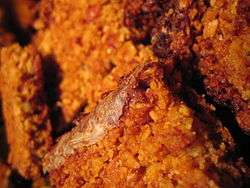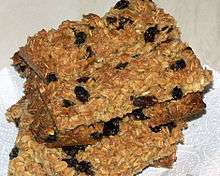Flapjack (oat bar)
 | |
| Type | Dessert bar |
|---|---|
| Place of origin | United Kingdom |
| Main ingredients | Rolled oats, butter, brown sugar, golden syrup/honey |
|
| |
A flapjack, muesli bar, cereal bar, or granola bar is a sweet tray-baked oat bar made from rolled oats, butter, brown sugar and golden syrup.
The item is known as a "flapjack" in the United Kingdom, the Isle of Man and Ireland and as a "muesli bar" or "cereal bar" in Australia and New Zealand. In other countries, including Canada, the United States, and South Africa, such products are referred to as "oat bars". In the UK, the term "cereal bar" is often used to describe products which contain fruits, nuts, other cereals apart from oats, and, occasionally, chocolate.
Overview

In the UK, the Isle of Man, Ireland, and Newfoundland a flapjack is a baked bar,[1] cooked in a flat oven tin and cut into rectangles, made from rolled oats, fat (typically butter), brown sugar and usually golden syrup.[2] As well as being baked at home, they are widely available in shops, ready-packaged, often with extra ingredients such as chocolate, dried fruit such as glace cherries, nuts, yoghurt and toffee pieces or coatings, either as individual servings or full unsliced trayfuls. A variant of them available in shops in the United Kingdom is known as the "Bakewell flapjack"[3]. Some flapjacks may contain maple syrup. They are usually an alternative to a biscuit (cookie) or cake, and textures range from soft and moist to dry and crisp.[1] Because of the high levels of fat and calories in traditional recipes, some "diet" versions are available with lower fat and calorie content. Similar products are known in Australia as muesli bars or simply 'a slice'. Similar products in North America are Hudson Bay Bread and granola bars[4].
History
The Oxford English Dictionary records the word "flapjack" as being used as early as the beginning of the 16th century, although at this time it seems to have been a flat tart[1] Shakespeare refers to "flap-jacks" in Pericles, Prince of Tyre, but this is one of the many anachronisms in his historical plays and does not suggest that he thought it was a middle eastern dish, merely a common English dessert of the time:
- "Come, thou shant go home, and we'll have flesh for holidays, fish for fasting-days, and moreo'er puddings and flap-jacks, and thou shalt be welcome."
- Act II Scene I
Later, flapjack would be used to describe something similar to an apple flan, but it is not until 1935 that the word is first used to describe a food made of oats.[1] While in the UK this usage has mostly superseded earlier recipes, in North America, "flapjack" still refers to pancakes.[1]
References
| Wikimedia Commons has media related to Flapjacks. |
| Wikibooks Cookbook has a recipe/module on |
- 1 2 3 4 5 1,001 Foods to Die For, Andrews McMeel Publishing, 2007, p. 866, ISBN 0-7407-7043-8
- ↑ Davidson, Alan; Jaine, Tom; Vannithone, Soun (2006) [1999], The Oxford Companion to Food (2nd ed.), Oxford University Press, p. 306, ISBN 0-19-280681-5
- ↑ http://allrecipes.co.uk/recipe/28578/bakewell-flapjack.aspx
- ↑ http://gingerandbread.com/2015/02/05/flapjacks-or-granola-bars-as-close-to-healthy-food-as-it-gets-i-suppose/